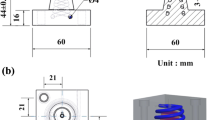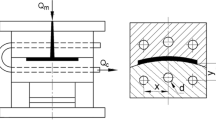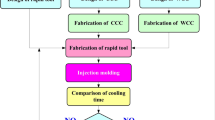Abstract
According to the practical experiences in the injection molding, the knowledge about conformal cooling channel (CCC) is an essential factor that affects productivity and quality of the molded part greatly. In general, the CCC provides a reduction in the cooling time in series production. However, the distance between cooling channel edges of the circular conformal cooling channel (CCCC) and mold cavity edge is not constant. The profiled conformal cooling channel (PCCC) has flat surface of the cooling channel facing the profile of the cavity fully. The distance between cooling channel edges of the PCCC and mold cavity edge is constant. In this study, two maraging steel injection molding tools with two different CCC were designed and fabricated by the direct metal printing technology. The difference between injection mold with PCCC and CCCC on the cooling time of the molded wax pattern, part temperature difference, mold surface temperature difference, and part warpage were numerically investigated using Moldex3D simulation software. It was found that the PCCC seems to be a good candidate in the CCC design and provides a better alternative in the conventional cooling channels. The PCCC reduced the cooling time about 33.33% compared with CCCC under the coolant water temperature of 25 °C. The temperature of 26 °C is the optimal value for the coolant water based on the dimensional accuracy of the wax pattern and energy consumption of the cooling system.




















Similar content being viewed by others
References
Abbès B, Abbès F, Abdessalam H, Upganlawar A (2019) Finite element cooling simulations of conformal cooling hybrid injection molding tools manufactured by selective laser melting. Int J Adv Manuf Technol 103(5–8):2515–2522
Mercado-Colmenero JM, Martin-Doñate C, Rodriguez-Santiago M, Moral-Pulido F, Rubio-Paramio MA (2019) A new conformal cooling lattice design procedure for injection molding applications based on expert algorithms. Int J Adv Manuf Technol 102(5–8):1719–1746
Au KM, Yu KM (2007) A scaffolding architecture for conformal cooling design in rapid plastic injection moulding. Int J Adv Manuf Technol 34(5–6):496–515
Saifullah ABM, Masood SH, Sbarski I (2012) Thermal–structural analysis of bi-metallic conformal cooling for injection moulds. Int J Adv Manuf Technol 62(1–4):123–133
Urbanic RJ, Saqib SM (2019) A manufacturing cost analysis framework to evaluate machining and fused filament fabrication additive manufacturing approaches. Int J Adv Manuf Technol 102(9–12):3091–3108
Snelling DA, Williams CB, Druschitz AP (2019) Mechanical and material properties of castings produced via 3D printed molds. Addit Manuf 27:199–207
Maravola M, Conner B, Walker J, Cortes P (2019) Epoxy infiltrated 3D printed ceramics for composite tooling applications. Addit Manuf 25:59–63
Kang J, Shangguan H, Deng C, Hu Y, Huang T (2018) Additive manufacturing-driven mold design for castings. Addit Manuf 22:472–478
Holker R, Tekkaya AE (2016) Advancements in the manufacturing of dies for hot aluminum extrusion with conformal cooling channels. Int J Adv Manuf Technol 83(5–8):1209–1220
Kitayama S, Miyakawa H, Takano M, Aiba S (2017) Multi-objective optimization of injection molding process parameters for short cycle time and warpage reduction using conformal cooling channel. Int J Adv Manuf Technol 88(5–8):1735–1744
Wang X, Li Z, Gu J, Ruan S, Shen C, Wang X (2016) Reducing service stress of the injection-molded polycarbonate window by optimizing mold construction and product structure. Int J Adv Manuf Technol 86(5–8):1691–1704
Song C, Yang Y, Liu Y, Luo Z, Yu J-K (2015) Study on manufacturing of W-Cu alloy thin wall parts by selective laser melting. Int J Adv Manuf Technol 78(5–8):885–893
Liu Y, Yang Y, Wang D (2016) A study on the residual stress during selective laser melting (SLM) of metallic powder. Int J Adv Manuf Technol 87(1–4):647–656
Abbès B, Abbès F, Abdessalam H et al (2019) Int J Adv Manuf Technol 103:2515–2522. https://doi.org/10.1007/s00170-019-03721-2
Reggiani B, Todaro I (2019) Investigation on the design of a novel selective laser melted insert for extrusion dies with conformal cooling channels. Int J Adv Manuf Technol. https://doi.org/10.1007/s00170-019-03879-9
Zhong H, Guo Z, Xiong J (2017) Liquid phase sintering-based diffusion bonding of Ti(C,N)-based cermet and steel. Int J Adv Manuf Technol 88(5–8):1813–1819
Williams CB, Cochran JK, Rosen DW (2011) Additive manufacturing of metallic cellular materials via three-dimensional printing. Int J Adv Manuf Technol 53(1–4):231–239
Maji PK, Banerjee PS, Sinha A (2008) Application of rapid prototyping and rapid tooling for development of patient-specific craniofacial implant: an investigative study. Int J Adv Manuf Technol 36(5–6):510–515
Yin S, Chen C, Yan X, Feng X, Lupoi R (2018) The influence of aging temperature and aging time on the mechanical and tribological properties of selective laser melted maraging 18Ni-300 steel. Addit Manuf 22:592–600
Kuo CC, Zhu YJ, Wu YZ et al (2019) Development and application of a large injection mold with conformal cooling channels. Int J Adv Manuf Technol. https://doi.org/10.1007/s00170-019-03614-4
Yao Y, Zhu H, Huang C, Wang J, Zhang P, Yao P (2019) Investigation on chip formation and surface integrity in micro end milling of maraging steel. Int J Adv Manuf Technol 102(5–8):1973–1984
Chen Q, Liang X, Hayduke D, Liu J, To AC (2019) An inherent strain based multiscale modeling framework for simulating part-scale residual deformation for direct metal laser sintering. Addit Manuf 28:406–418
Sanz C, Gerard R, Morantz P, Chérif A, Lunt AJG (2018) Micro-scale finishing of the surface and form of a Ti-6Al-4V lightweight rotor obtained by laser powder bed fusion used for air bearing. Addit Manuf 23:287–293
Yu W, Ruan S, Li Z, Gu J, Wang X, Shen C, Chen B (2019) Effect of injection velocity on the filling behaviors of microinjection-molded polylactic acid micropillar array product. Int J Adv Manuf Technol 103:2929–2940
Chen WC, Nguyen MH, Chiu WH, Chen TN, Tai PH (2016) Optimization of the plastic injection molding process using the Taguchi method, RSM, and hybrid GA-PSO. Int J Adv Manuf Technol 83:1873–1886
Kuo CC, Xu WC (2018) Effects of different cooling channels on the cooling efficiency in the wax injection molding process. Int J Adv Manuf Technol 98:887–895
Fu J, Ma Y (2018) Computer-aided engineering analysis for early-ejected plastic part dimension prediction and quality assurance. Int J Adv Manuf Technol 98:2389–2399
Kanbur BB, Suping S, Duan F (2020) Design and optimization of conformal cooling channels for injection molding: a review. Int J Adv Manuf Technol 106:3253–3271
Kuo CC, Jiang ZF, Lee JH (2019) Effects of cooling time of molded parts on rapid injection molds with different layouts and surface roughness of conformal cooling channels. Int J Adv Manuf Technol 103:2169–2182
Wang D, Dong A, Zhu G, Shu D, Sun J, Li F, Sun B (2019) Rapid casting of complex impeller based on 3D printing wax pattern and simulation optimization. Int J Adv Manuf Technol 100(9–12):2629–2635
Cui K, Wang W, Jiang R, Zhao D (2018) Layout optimization method for core holders in wax pattern mold of hollow turbine blade. Int J Adv Manuf Technol 98(1–4):1031–1045
Jiang RS, Zhang DH, Bu K, Wang WH, Tian JW (2017) A deformation compensation method for wax pattern die of turbine blade. Int J Adv Manuf Technol 88(9–12):3195–3203
Hasan M, Zhao J, Huang Z, Wei D, Jiang Z (2019) Analysis and characterisation of WC-10Co and AISI 4340 steel bimetal composite produced by powder–solid diffusion bonding. Int J Adv Manuf Technol 103(9–12):3247–3263
Ling Z, Wu J, Wang X, Li X, Zheng J (2019) Experimental study on the variance of mechanical properties of polyamide 6 during multi-layer sintering process in selective laser sintering. Int J Adv Manuf Technol 101(5–8):1227–1234
Yan A, Wang Z, Yang T, Wang Y, Ma Z (2017) Sintering densification behaviors and microstructural evolvement of W-Cu-Ni composite fabricated by selective laser sintering. Int J Adv Manuf Technol 90(1–4):657–666
Yamamoto S, Azuma H, Suzuki S, Kajino S, Sato N, Okane T, Nakano S, Shimizu T (2019) Melting and solidification behavior of Ti-6Al-4V powder during selective laser melting. Int J Adv Manuf Technol 103(9–12):4433–4442
Wei D, Anniyaer A, Koizumi Y, Aoyagi K, Chiba A (2019) On microstructural homogenization and mechanical properties optimization of biomedical Co-Cr-Mo alloy additively manufactured by using electron beam melting. Addit Manuf 28:215–227
Le TN, Lo YL, Tran HC (2019) Multi-scale modeling of selective electron beam melting of Ti6Al4V titanium alloy. Int J Adv Manuf Technol. https://doi.org/10.1007/s00170-019-04188-x
Scharowsky T, Bauereiß A, Körner C (2017) Influence of the hatching strategy on consolidation during selective electron beam melting of Ti-6Al-4V. Int J Adv Manuf Technol 92(5–8):2809–2818
Riedlbauer D, Scharowsky T, Singer RF, Steinmann P, Körner C, Mergheim J (2017) Macroscopic simulation and experimental measurement of melt pool characteristics in selective electron beam melting of Ti-6Al-4V. Int J Adv Manuf Technol 88(5–8):1309–1317
Liang W, Kang X, Zhao W, Yang Y (2016) Electrical discharge machining of electron beam melting formed shrouded blisk. Int J Adv Manuf Technol 87(5–8):2319–2326
Pobel CR, Reichel S, Fu Z, Osmanlic F, Körner C (2019) Advanced process strategy to realize microducts free of powder using selective electron beam melting. Int J Adv Manuf Technol 103(1–4):1291–1296
Ameen W, Al-Ahmari A, Mohammed MK (2019) Self-supporting overhang structures produced by additive manufacturing through electron beam melting. Int J Adv Manuf Technol. https://doi.org/10.1007/s00170-019-04007-3
Al-Tamimi AA, Huang B, Vyas C et al (2019) Topology optimised metallic bone plates produced by electron beam melting: a mechanical and biological study. Int J Adv Manuf Technol. https://doi.org/10.1007/s00170-019-03866-0
Hossain MS, Mireles J, Morton P, Lin Y, Terrazas CA, Wicker RB (2018) Part re-registration during process interruption of electron beam melting additive manufacturing. Int J Adv Manuf Technol 96(1–4):337–344
Ujah CO, Popoola API, Popoola OM, Aigbodion VS (2019) Optimisation of spark plasma sintering parameters of Al-CNTs-Nb nano-composite using Taguchi Design of Experiment. Int J Adv Manuf Technol 100(5–8):1563–1573
Shao W, Liu XF, Wu Z (2019) A robust weld seam detection method based on particle filter for laser welding by using a passive vision sensor. Int J Adv Manuf Technol 104:2971–2980
Zheng Q, Zhuang X, Gao Z, Guan M, Ding Z, Hong Y, Zhao Z (2019) Investigation on wear-induced edge passivation of fine-blanking punch. Int J Adv Manuf Technol 104:4129–4141
Adnan MF, Abdullah AB, Samad Z (2017) Springback behavior of AA6061 with non-uniform thickness section using Taguchi Method. Int J Adv Manuf Technol 89(5–8):2041–2052
Akıncıoglu S, Gokkaya H, Uygur I (2016) The effects of cryogenic-treated carbide tools on tool wear and surface roughness of turning of Hastelloy C22 based on Taguchi method. Int J Adv Manuf Technol 82(1–4):303–314
Limon-Romero J, Tlapa D, Baez-Lopez Y, Maldonado-Macias A, Rivera-Cadavid L (2016) Application of the Taguchi method to improve a medical device cutting process. Int J Adv Manuf Technol 87(9–12):3569–3577
Effertz PS, Quintino L, Infante V (2017) The optimization of process parameters for friction spot welded 7050-T76 aluminium alloy using a Taguchi orthogonal array. Int J Adv Manuf Technol 91(9–12):3683–3695
Han SR, Cho JR, Beak SK, Hong JA, Lee YS (2017) Numerical and experimental studies of injection compression molding process for thick plastic gas valve stem. Int J Adv Manuf Technol 89(1–4):651–660
Zhang Y, Mao T, Huang Z, Gao H, Li D (2016) A statistical quality monitoring method for plastic injection molding using machine built-in sensors. Int J Adv Manuf Technol 85(9–12):2483–2494
Fuentes-Huerta MA, González-González DS, Cantú-Sifuentes M, Praga-Alejo RJ (2018) RCM implementation on plastic injection molding machine considering correlated failure modes and small size sample. Int J Adv Manuf Technol 95(9–12):3465–3473
Hentati F, Hadriche I, Masmoudi N et al (2019) Int J Adv Manuf Technol 104:4353–4363. https://doi.org/10.1007/s00170-019-04283-z
Krebelj K, Halilovič M, Mole N (2019) The cooling rate dependence of the specific volume in amorphous plastic injection molding. Int J Adv Manuf Technol 103(1–4):1175–1184
Alvarado-Iniesta A, Cuate O, Schütze O (2019) Multi-objective and many objective design of plastic injection molding process. Int J Adv Manuf Technol 102(9–12):3165–3180
Safarian A, Subaşi M, Karataş Ç (2017) The effect of sintering parameters on diffusion bonding of 316L stainless steel in inserted metal injection molding. Int J Adv Manuf Technol 89(5–8):2165–2173
Sahli M, Lebied A, Gelin J-C, Barrière T, Necib B (2015) Numerical simulation and experimental analysis of solid-state sintering response of 316 L stainless steel micro-parts manufactured by metal injection molding. Int J Adv Manuf Technol 79(9–12):2079–2092
Hayat MD, Li T, Wen G, Cao P (2015) Suitability of PEG/PMMA-based metal injection moulding feedstock: an experimental study. Int J Adv Manuf Technol 80(9–12):1665–1671
Lamarre SG, Demers V, Chatelain J-F (2017) Low-pressure powder injection molding using an innovative injection press concept. Int J Adv Manuf Technol 91(5–8):2595–2605
Oh JW, Lee WS, Park SJ (2018) Investigation and modeling of binder removal process in nano/micro bimodal powder injection molding. Int J Adv Manuf Technol 97(9–12):4115–4126
Zakaria MY, Sulong AB, Muhamad N, Ramli MI (2019) Rheological properties of titanium-hydroxyapatite with powder space holder composite feedstock for powder injection moulding. Int J Adv Manuf Technol 102(5–8):2591–2599
Acknowledgments
The skillful technical assistance in mold making by Ding-Yang Xu of Ming Chi University of Technology is highly appreciated.
Funding
This study was financially supported by the Ministry of Science and Technology of Taiwan under contract nos. MOST 107-2221-E-131-018, MOST 106-2221-E-131-010, MOST 106-2221-E-131-011, and MOST 105-2221-E-131-012.
Author information
Authors and Affiliations
Corresponding author
Additional information
Publisher’s note
Springer Nature remains neutral with regard to jurisdictional claims in published maps and institutional affiliations.
Rights and permissions
About this article
Cite this article
Kuo, CC., Jiang, ZF., Yang, XY. et al. Characterization of a direct metal printed injection mold with different conformal cooling channels. Int J Adv Manuf Technol 107, 1223–1238 (2020). https://doi.org/10.1007/s00170-020-05114-2
Received:
Accepted:
Published:
Issue Date:
DOI: https://doi.org/10.1007/s00170-020-05114-2




